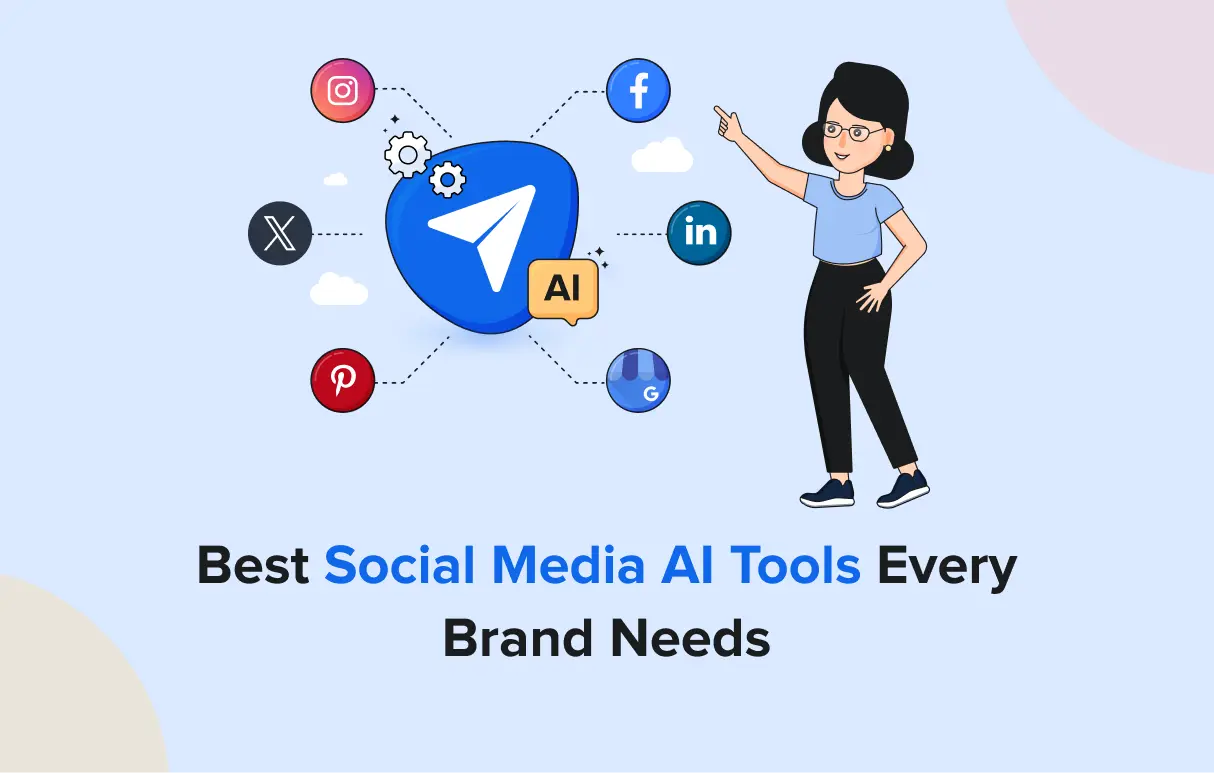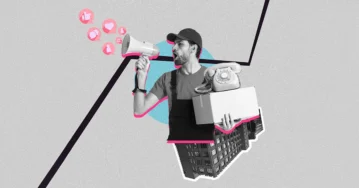If you’ve ever asked yourself whether social media is worth the effort or questioned when you’ll finally see ROI, you’re not alone.
I’ve worked with social media managers, agencies, and business owners who’ve wrestled with the same thing. But when done right, social media impact on business can be game-changing, not just for visibility, but for real growth.
In this guide, I’ll walk you through the impact I’ve seen firsthand: the wins, the lessons, and the strategies that truly pay off.
Whether you’re just getting started or trying to scale smarter, this is everything I wish someone had told me earlier.
Social media has a powerful positive impact on business growth. I have seen businesses transform from building brand awareness to driving sales and providing customer service, and leveraging the right strategies can transform your business, too.
Here are the top benefits with real-life examples of how businesses use social media to succeed.
1. Build Brand Awareness — And Make It Stick
Brand awareness is about making your business recognizable, not just by name, but through its identity, voice, and values. Social media offers a unique opportunity for even small businesses to stand out alongside major brands and make a lasting impression.
People don’t buy from brands they don’t know. Social media is a powerful tool for staying visible in a crowded market, and businesses with a consistent presence are more likely to be tagged, shared, and chosen over time.
How it Works in Practice:
Building awareness isn’t about shouting louder; it’s about showing up consistently and authentically. Focus on:
- A strong visual identity (color, tone, style)
- Telling your brand story in bite-sized formats
- Using platform-native formats like Reels, Stories, and Carousels
- Sharing user-generated content and behind-the-scenes moments
When & Where to Focus It:
- Best platforms: Instagram, TikTok, LinkedIn
- Best times: Daily or 3-5x a week, especially around key events or launches
- Best formats: Short-form videos, carousels, behind-the-scenes content
Brand on Point:
Gymshark, a small fitness brand from the UK, grew to a $1.4 billion valuation by focusing on brand awareness through consistent, engaging content on Instagram.
They didn’t rely on big ad spend but instead told stories that resonated with their audience, from product showcases to fitness transformations.
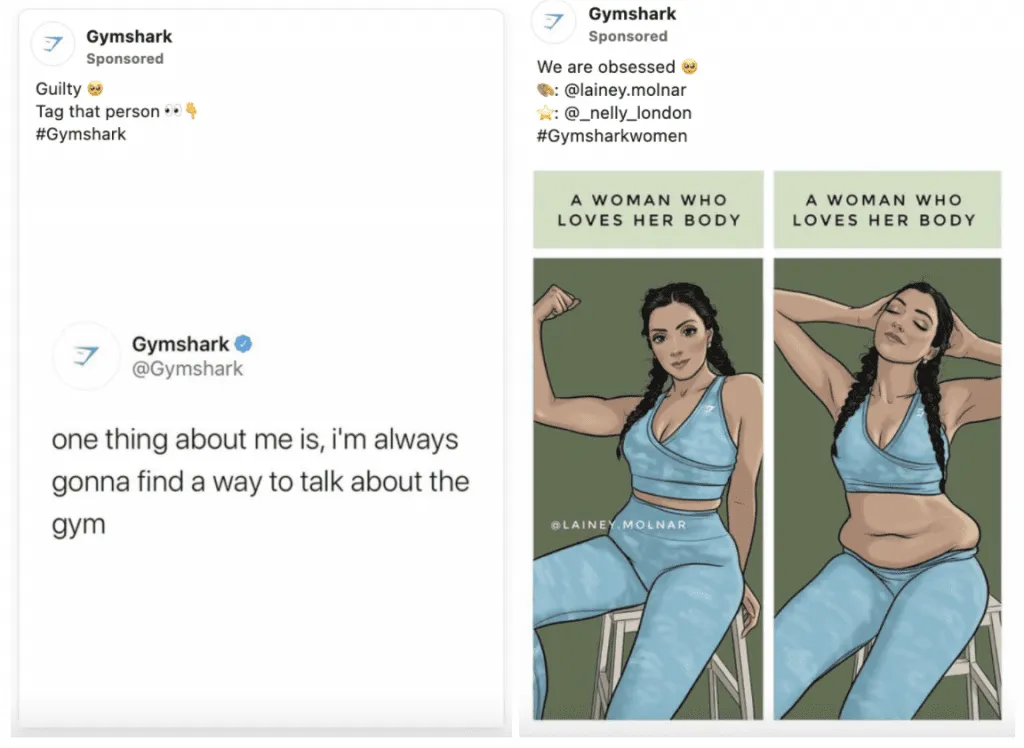
“Focus on creating valuable, engaging content that resonates with your audience. Consistency is key — post regularly and ensure your content is aligned with your brand’s identity and values.”
— Neil Patel, Digital Marketing Expert
2. Strengthen Customer Relationships Through Genuine Engagement
Social media’s true power lies in conversation, not just broadcasting content. Engagement is about building trust and loyalty through meaningful two-way interactions, from replying to comments to resharing customer posts.
The brands that thrive on social media are the ones that make their customers feel heard. This fosters loyalty, encourages referrals, and boosts brand advocacy. Plus, engaging helps your content perform better algorithmically.
How it Works in Practice:
Meaningful engagement includes:
- Replying to comments and DMs personally
- Using polls and questions in Stories for interaction
- Resharing user-generated content and tagging creators
- Highlighting testimonials or feedback
- Responding empathetically to criticism
When & Where to Focus It:
- Best platforms: Instagram, Facebook, LinkedIn
- Best timing: Respond within 24 hours, schedule Stories and polls around active hours
- Best formats: Q&As, behind-the-scenes, user spotlights
Brand on Point:
Glossier built a loyal following by engaging with its audience through direct DMs, reposting user content, and using feedback to shape product development.
See how they engage with their community without fail.
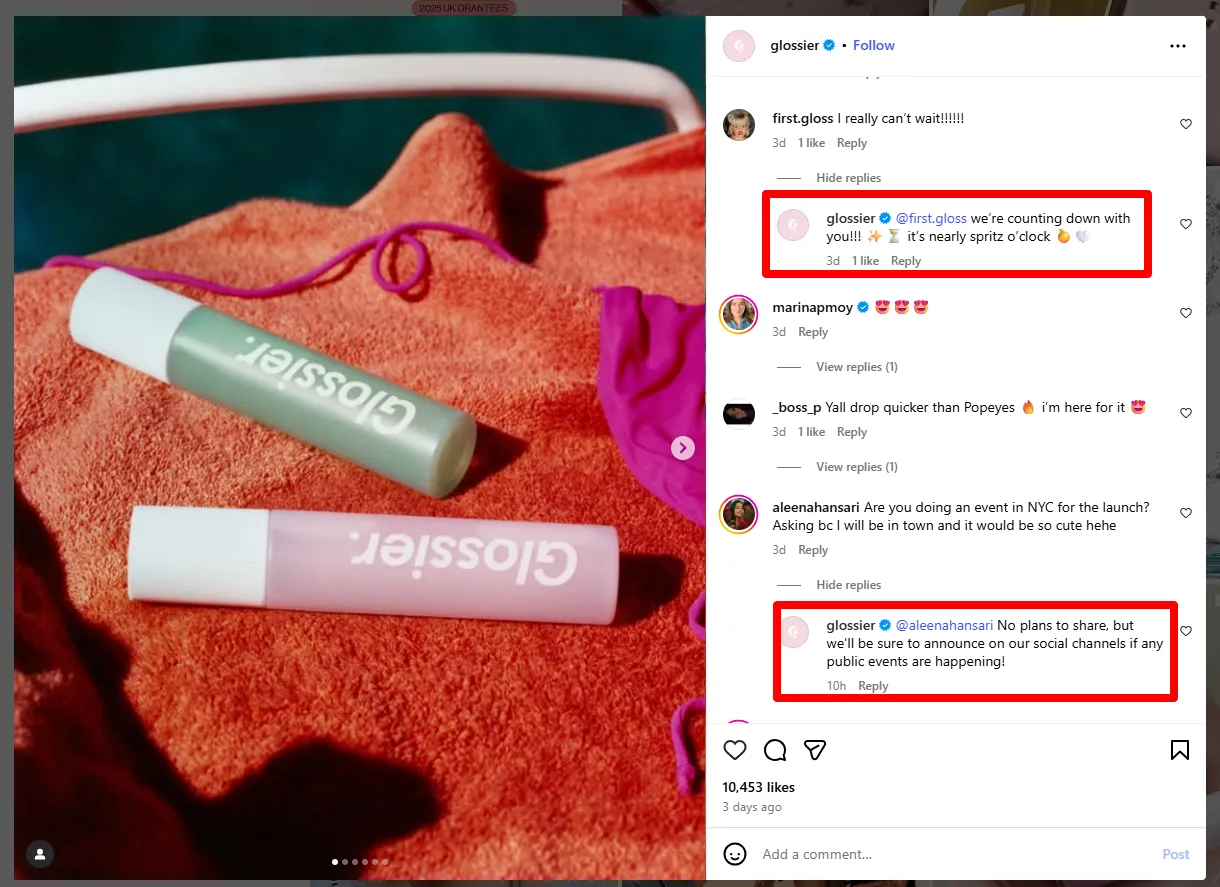
Their approach reduced social media marketing costs and helped grow the brand to a $1.2 billion valuation, fueled by genuine engagement on Instagram.
Takeaway for businesses: You don’t need a large team or agency budget to build a connection. Start by answering every comment. Celebrate your customers. Make them part of the story. Over time, that trust pays back in sales, referrals, and retention.
3. Generate Quality Leads — Without Relying on Paid Ads
Lead generation on social media is about attracting potential customers and guiding them into your sales funnel. While ads can help, many businesses generate quality leads organically with the right content, timing, and engagement from social media.
For small and medium businesses, affordable lead generation is crucial. Social media allows you to educate, nurture, and build trust with potential buyers before they’re ready to purchase, and no massive ad budgets are required.
“To generate organic leads, focus on providing value upfront. Offer free resources such as guides, webinars, or templates, and use strong CTAs to guide prospects down the sales funnel.”
— Ann Handley, Content Marketing Expert
How it Works in Practice:
To generate leads, focus on solving problems, not selling. Here’s what works:
- Create content addressing pain points (how-tos, tips)
- Offer value upfront (free templates, checklists) in exchange for contact info
- Use strong CTAs (e.g., “DM us for a free audit”)
- Leverage gated content (webinars, challenges, downloadable resources)
- Include clear lead capture pathways (UTM links, landing pages, chatbots)
When & Where to Focus It:
- Best platforms: LinkedIn, Instagram, Facebook, YouTube
- Best timing: 1-2 weeks before campaigns or product launches
- Best formats: Carousels, Reels, live sessions
Brand on Point:
SocialPilot uses content-driven lead magnets like newsletters, blog posts, guides, and webinars to generate leads without ads.
Their strategy, offering free resources and guides, helped them grow to over 15000+ users and 170k followers on LinkedIn, with many converting without paid ads.
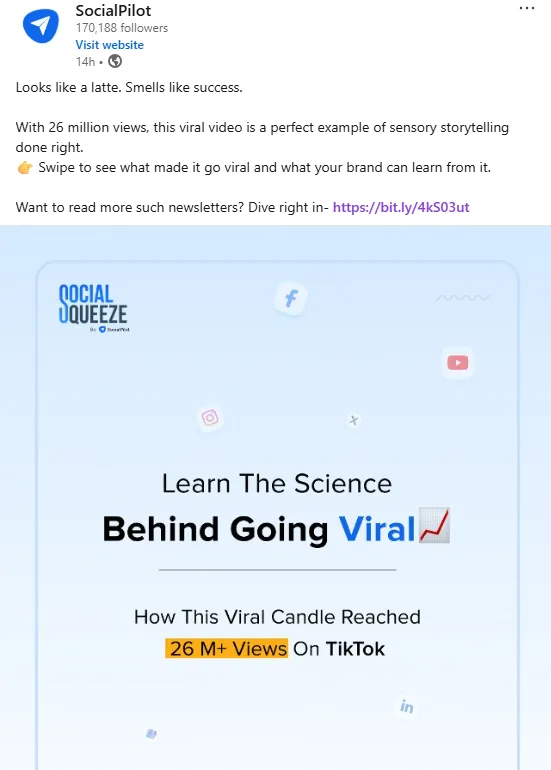
Takeaway from brand: You don’t need ads to generate qualified leads. Create valuable content, guide your audience to the next step, and stay consistent. Social media is the perfect channel to build trust and drive conversions, even without a large budget.
4. Drive Website Traffic That Actually Converts
Social media is a powerful tool for driving targeted traffic to your website, whether it’s a homepage, landing page, or eCommerce store. The key is sending the right people who are more likely to convert into leads, customers, or subscribers.
“Don’t just send traffic to your homepage. Instead, create specific landing pages for your social media campaigns that speak directly to the audience’s needs and pain points, and ensure the page has a clear call to action.”
— Brian Dean, Backlinko
Your website is where conversions happen. Social media creates the spark, but trust is built on your website, and actions are taken. Without intentionally guiding traffic there, your content might generate traffic but not meaningful conversions.
How it Works in Practice:
To turn social traffic into meaningful site visits:
- Use clear calls-to-action (CTAs) in captions and stories to guide your audience
- Track conversions with UTM parameters
- Use “link in bio” tools like Linktree to maximize link clicks
- Share teaser content linking to more detailed blog posts or landing pages
- Post visuals and videos that tie into high-converting pages
When & Where to Focus It:
- Best platforms: Instagram, Facebook, Pinterest, LinkedIn
- Best timing: Before a campaign launch, after publishing high-value content, or during low-traffic seasons
- Best formats: Carousels, Reels, Infographics, and Stories with pinned CTAs
Brand on Point:
Beardbrand drives traffic with value-packed YouTube tutorials and Instagram posts, linking directly to product pages.
This consistent, educational, and entertaining content helped them build a 7-figure business with social media as their primary traffic driver.
See how they promote their products and redirect their YouTube audience to their website and product pages.
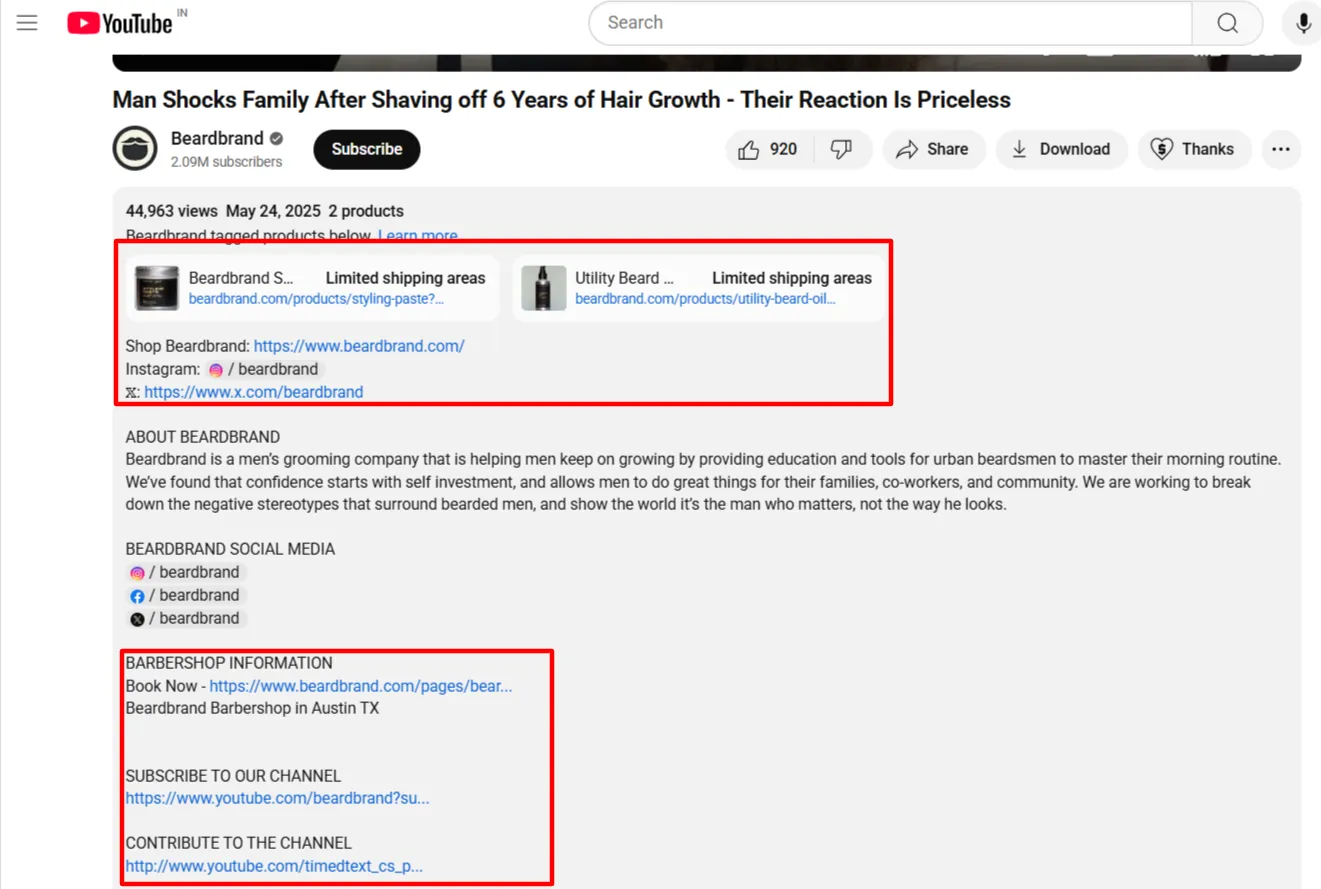
Takeaways from the brand: Social media is your best tool to drive website traffic, but you must guide people with clear CTAs and compelling content. Track what works, stay consistent, and make it easy for people to click through.
5. Deliver Public-Facing, Real-Time Customer Service
Social media is your 24/7 customer service desk. It’s not just for social media marketing; it’s where you respond to questions, solve problems, and handle complaints in real-time. When done well, your service is visible to others, building trust and managing your public reputation.
Customers expect fast responses. Social media provides quicker and more visible support, which boosts existing customers’ confidence. A helpful, timely response builds trust, while slow or poor responses can lead to public complaints and negative reviews.
How it Works in Practice:
Effective customer service on social media involves:
- Monitoring mentions, comments, and DMs in real-time
- Using saved replies for common questions, but personalizing responses
- Responding publicly to praise or complaints, and handling sensitive issues privately
- Adding personality with emojis, voice notes, or videos
- Maintaining a quick response time with a friendly tone
When & Where to Focus It:
- Best platforms: Twitter/X, Instagram DMs, Facebook Messenger, Google Business Profile
- Best timing: During launches, promo periods, weekends, evenings, or when tagged in posts
- Best practices: Respond within 2 hours, resolve publicly, follow up privately, and thank users for feedback (even negative)
Brands on Point:
JetBlue uses Twitter/X very actively as a frontline support channel, responding faster than their phone or email systems. They engage with empathy, offering solutions quickly.
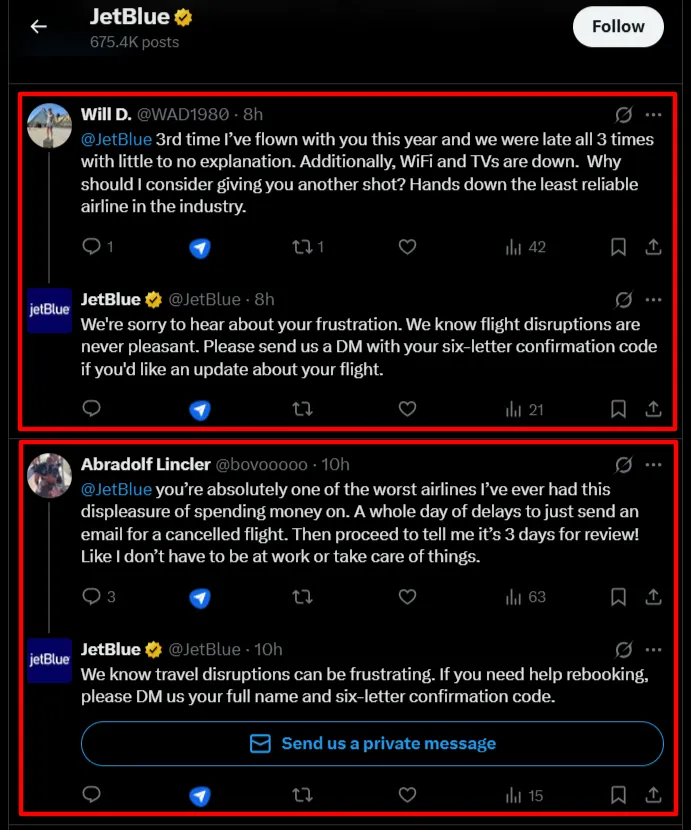
This approach has helped JetBlue build trust and outperform larger competitors in customer sentiment.
Takeaway from brand: Social media is where customer service happens now. Respond quickly, be kind, and handle issues publicly and privately. How you respond builds trust, and everyone is watching.
Social proof — such as online reviews, user-generated content, testimonials, and influencer mentions — builds trust. When paired with shoppable features like Instagram product tags or TikTok Shop, you remove friction from the buyer’s journey, making it easy for customers to see, trust, and buy products instantly.
I’ve seen brands with great products struggle to convert visitors into buyers. Once we added UGC and shoppable posts, their conversion rates soared. Social proof builds credibility, and shoppable content makes buying easier. Together, they drive sales.
How it Works in Practice:
Here’s how I help brands leverage social proof and shoppable features:
- Encourage UGC by offering incentives, contests, or simply asking for tags
- Repost UGC, especially showing real-life product usage
- Add product tags to posts for easy, instant purchases
- Use influencer marketing methods, even from micro-influencers, to boost trust
- Create Story Highlights with testimonials and success stories
When & Where to Focus It:
- Best platforms: Instagram, TikTok, Pinterest, Facebook Shop
- Best timing: Before and during product launches, post-purchase follow-ups, promoting bestsellers, or seasonal bundles
- Best formats: Carousel reviews, customer spotlight Reels/TikToks, Before/After transformations
Brand on Point:
Fenty Beauty combines social proof and shoppable content seamlessly.
They encourage real customers and influencers to share tutorials and reviews while using Instagram Shopping and TikTok to make it easy for fans to buy directly from posts.
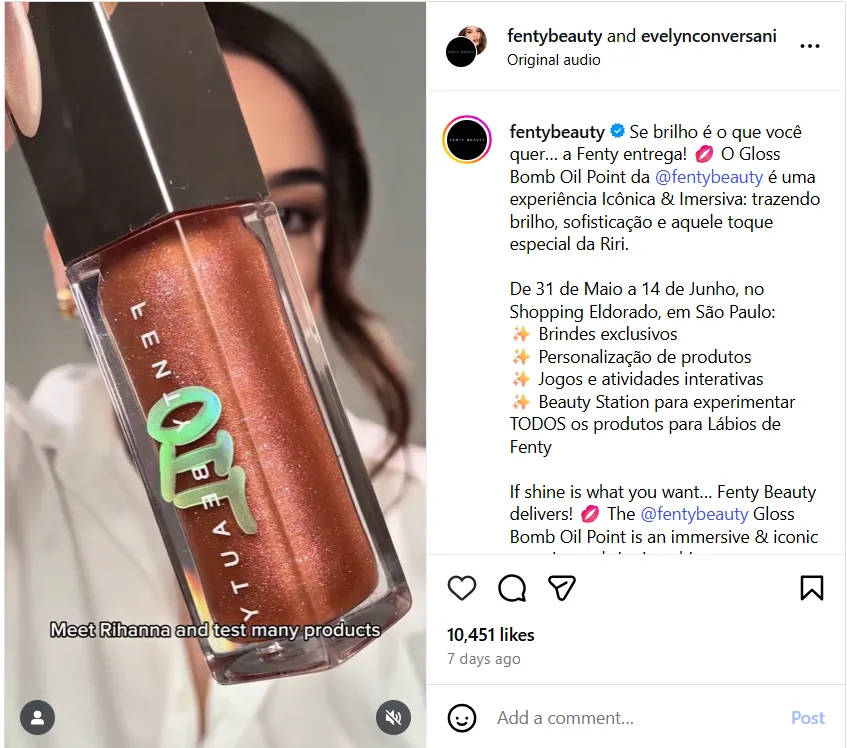

This strategy contributed to Fenty’s $500 million revenue in its first year.
Takeaway from brand: When customers see others using and loving your product, and can buy it with one tap, conversion becomes seamless. Show your product’s value through your community, and make the buying process effortless.
Social media can transform a business, but it’s not a quick fix. I’ve seen clients with high expectations get frustrated when results don’t come fast, often due to common misconceptions and challenges.
1. Unrealistic Expectations of Fast ROI
Many small businesses expect instant results from social media, hoping one viral post will bring hundreds of customers. However, social media thrives on long-term marketing strategy and relationship-building, not quick fixes.
Expecting immediate ROI can lead to disappointment and burnout. Without consistent engagement and strategy, progress feels stagnant.
“Don’t expect instant results from social media. The key to success is consistency and continuous engagement. Be patient, track your performance, and optimize your strategy over time.”
— Gary Vaynerchuk, Entrepreneur
Chubbies Shorts, known for its humorous Instagram presence, went viral after months of little return. They faced months of little return on social investments before seeing measurable growth.
They learned that consistent content, building relationships, and leveraging UGC drove better ROI than chasing viral hits.
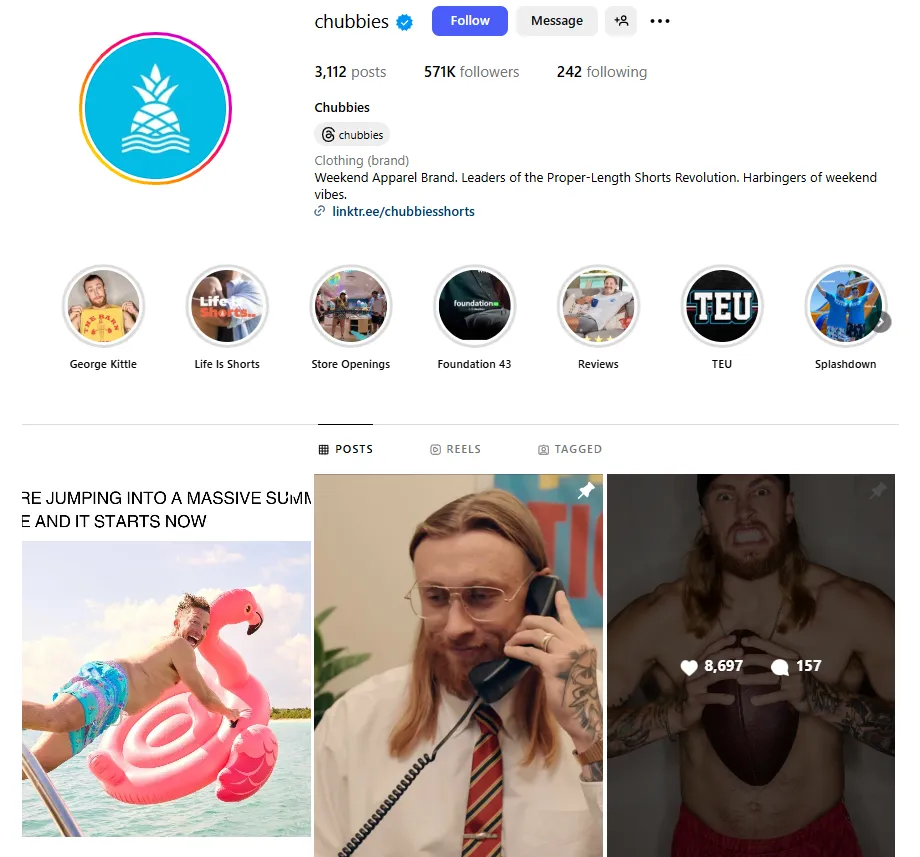
Lesson: Real social media ROI comes from steady, consistent content and engaging over time.
2. Content Inconsistency or Wrong Audience Targeting
Inconsistent posting or content that doesn’t align with your audience’s interests can hinder growth and lead to disengagement. Misunderstanding what your followers care about wastes time and effort.
Without consistency and target audience focus, you risk getting lost in the noise, making it harder to build a strong brand identity and trust.
A fitness brand posted randomly, switching between motivational quotes and tutorials. First, they ned to define clear content pillars, like workout tips and client success stories, engagement will skyrocket, and they will build a loyal community.
3. Time/Resource Strain for Small Teams
Social media management can overwhelm small teams, as balancing content creation with customer service and other tasks can feel impossible. This strain often leads to inconsistent efforts and frustration.
Limited resources can lead to burnout, inconsistent posting, and poor engagement, all of which diminish the effectiveness of social media efforts.
The Sill, an online plant store, struggled with content consistency and engagement due to a small team. By using scheduling tools like SocialPilot, they streamlined posting, increased engagement by 30%, and maintained regular interaction without burnout.
Lesson: Automating content scheduling and engagement helps small businesses scale without overwhelming resources.
Struggling to keep up with your social media content calendar?
With SocialPilot’s scheduling and publishing feature, you can plan ahead, stay consistent, and free up valuable time. Here’s what you can do:
- Schedule posts in bulk across multiple platforms.
- Customize posting times for optimal engagement.
- Auto-publish content on a recurring schedule.
- Manage multiple client accounts with ease.
- Track content performance through real-time insights.

Social media’s impact varies significantly across industries, with each vertical leveraging platforms to meet unique business goals, from increasing brand visibility to fostering customer loyalty and driving conversions.
Here’s how different sectors harness the power of social media to their advantage.
1. Retail
Retail businesses, especially B2C eCommerce brands, benefit the most from social media’s ability to create visual, engaging content that drives awareness and converts followers into customers.
Platforms like Instagram, TikTok, and Facebook allow retail brands to visually showcase products, demonstrate usage, and run shoppable ads that make the buying process seamless.
- Social media amplifies brand visibility by showing products in real-life contexts and engaging users with interactive content.
- Instagram Shopping and TikTok Shopping allow users to click directly on products from posts, making it easier to convert casual browsers into buyers.
- Social media provides a platform for real-time engagement, which boosts customer loyalty through direct interaction.
Boohoo, a fast-fashion retailer, uses TikTok influencer-driven viral challenges to generate buzz and convert followers into customers quickly.
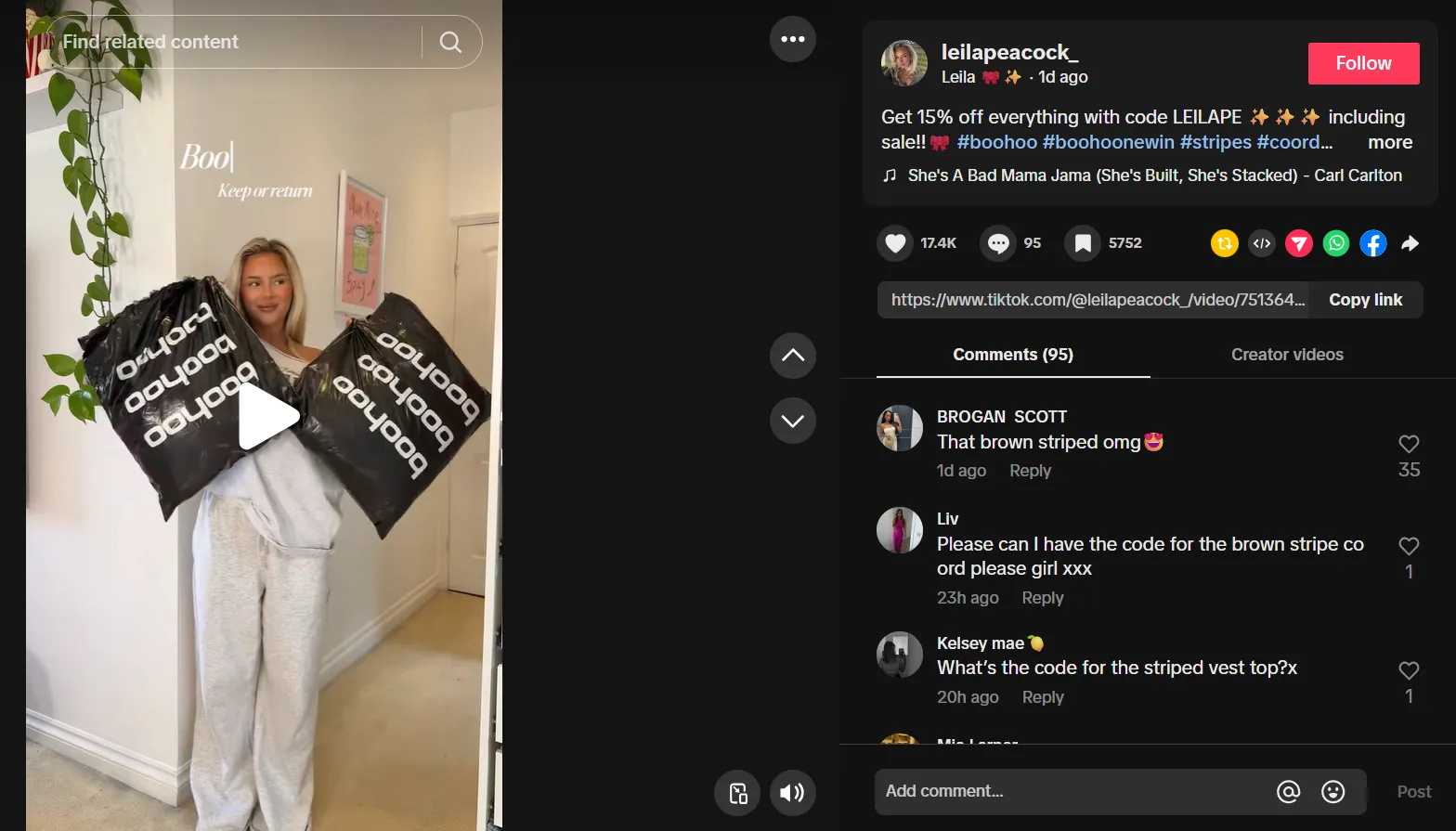
2. Healthcare
For healthcare providers (clinics, private practices, wellness brands), social media serves as a platform to educate patients, build trust, and increase brand visibility.
Facebook, Instagram, and YouTube are powerful tools for healthcare professionals to share informative content, patient success stories, and wellness tips.
- Social media helps healthcare brands engage with patients on a personal level, making the brand more approachable.
- YouTube allows for video content like virtual consultations, medical tips, and patient testimonials, establishing credibility and trust.
- Platforms like Facebook and Instagram offer targeted local advertising to attract nearby patients.
“In healthcare, trust is everything. Use social media to share educational content, patient success stories, and behind-the-scenes looks at your practice to humanize your brand and build trust with your audience.”
— Mike Pugh, Healthcare Social Media Consultant
Cleveland Clinic, a large nonprofit medical center, used YouTube and Facebook to build a community around its health initiatives. Their educational content encouraged patients to learn, understand, and implement a healthier lifestyle.
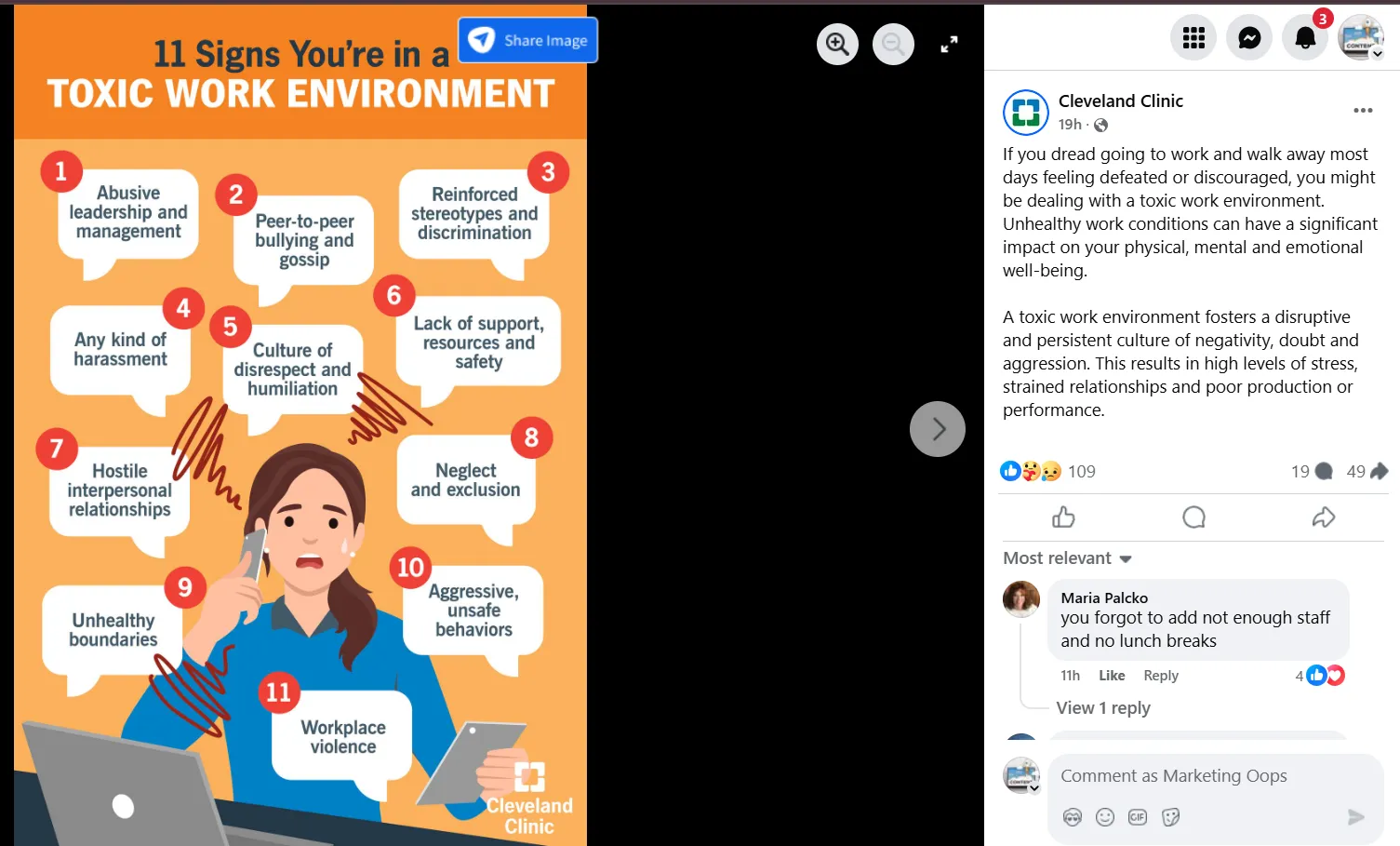
3. B2B SaaS
For B2B SaaS companies, LinkedIn is the most valuable platform for lead generation and authority building. SaaS businesses need to position themselves as industry leaders, and social media allows them to share case studies, thought leadership articles, and product demonstrations that attract decision-makers.
- LinkedIn provides a professional network where you can build trust through content marketing (articles, whitepapers, case studies).
- LinkedIn Ads can be highly targeted to specific job titles, industries, and companies, making lead generation more effective.
- Social media helps build industry relationships that can eventually convert into partnerships or sales.
SocialPilot, a leading B2B SaaS company, successfully grew its social media presence on LinkedIn through thought leadership. By posting articles, industry insights, and customer case studies, SocialPilot positioned itself as an authority in the social media marketing space, resulting in consistent leads and business growth.
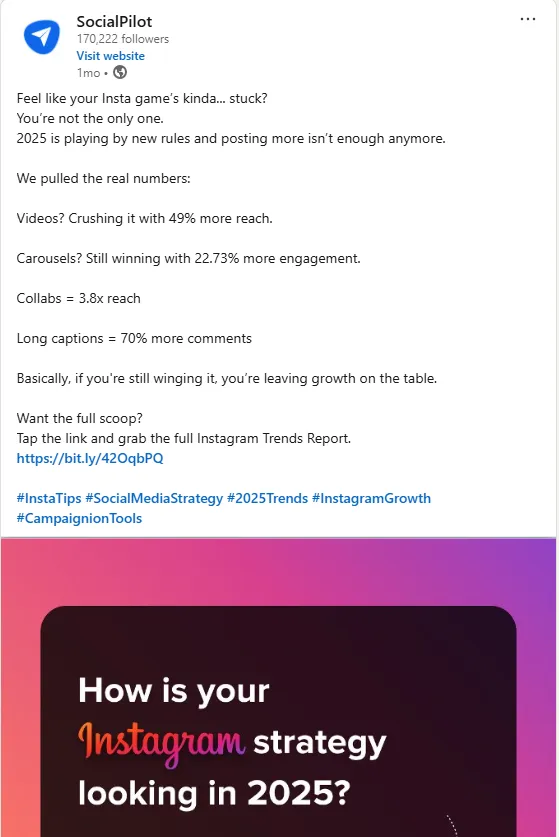
4. Hospitality
Hotels, resorts, and restaurants, the overall hospitality industry thrives on social media by creating shareable experiences that customers want to talk about. Instagram, Facebook, and TikTok are ideal platforms for showcasing experiential content — think beautiful hotel rooms, local attractions, and unique dining experiences.
- Visual platforms like Instagram and TikTok allow brands to capture the experience of staying at a hotel or dining at a restaurant.
- User-generated content (UGC), such as customer reviews and photos, adds social proof to attract new guests.
- Restaurants can build local customer loyalty through Facebook Events and Instagram Live cooking shows or tasting sessions.
Marriott Hotels has successfully used Instagram and YouTube to build a global community by sharing experiences, behind-the-scenes footage, and customer stories. Marriott also collaborates with travel influencers, which has significantly boosted direct bookings.
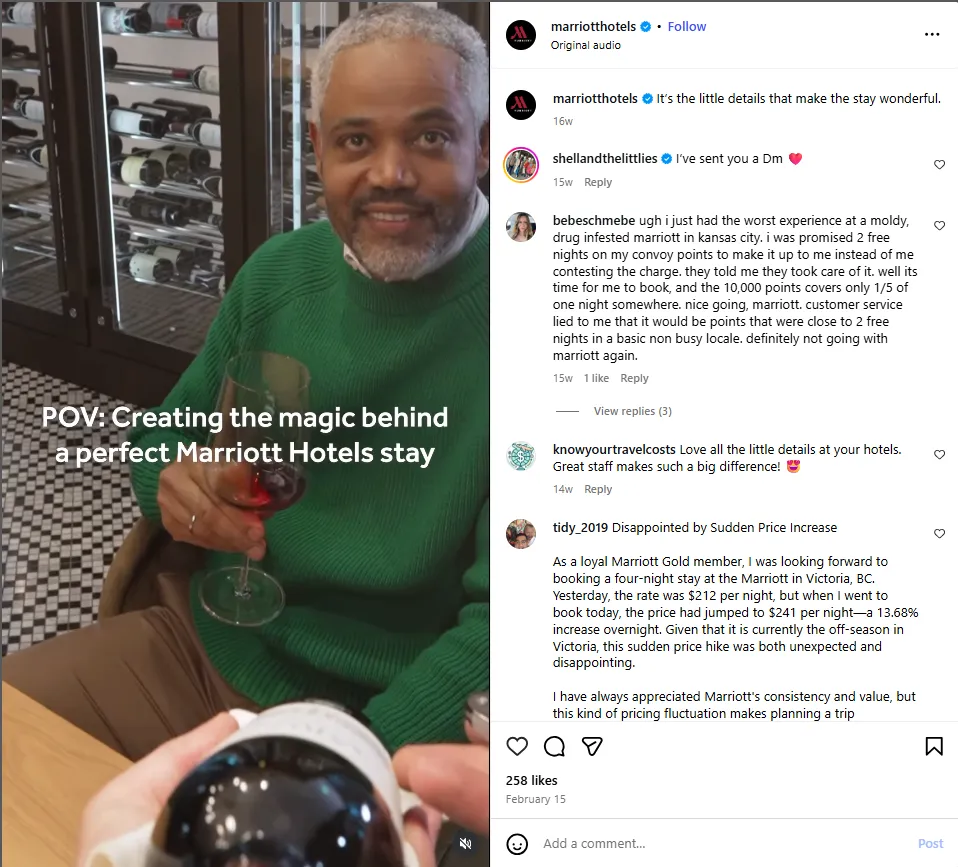
5. Education
For educational institutions and e-learning platforms, social media offers a great opportunity to connect with potential students, share success stories, and position the brand as an expert in their field. Social media platforms like LinkedIn, Instagram, and Facebook are perfect for sharing educational resources, student testimonials, and expert interviews.
- Social media provides the perfect platform for showcasing success stories and student testimonials, which build trust.
- YouTube allows institutions to offer free tutorials, webinars, and course previews that act as lead magnets.
- Instagram and Facebook help create community-driven conversations, boosting brand credibility and student engagement.
Coursera, a massive open online course (MOOC) provider, uses LinkedIn and Facebook to engage with prospective students. They post success stories, course previews, and influencer partnerships. This marketing strategy has helped them grow into a leading educational platform with millions of active users worldwide.

6. Real Estate
Real estate agents and property developers can leverage social media to promote property listings, offer virtual tours, and share client testimonials. Facebook, Instagram, and LinkedIn are the top social media platforms for connecting with potential buyers and creating a trust-based relationship.
- Instagram is highly visual, allowing agents to showcase properties through stunning photos and videos.
- Facebook Ads offer advanced targeting to local buyers and investors, enabling agents to reach the right audience effectively.
- LinkedIn allows agents to build professional credibility and network with business clients.
Ryan Serhant, a top real estate agent from NYC, has built his brand on social media by consistently posting property tours, client success stories, and real estate tips. His presence on Instagram and YouTube has helped him grow a massive following, contributing to his success as a leading luxury real estate agent.

For SMBs, agencies, and corporations, social media ROI is the key question regarding social media. They want to know: “Is social media worth it?” and “How do I measure social media impact on my business?” Here’s a breakdown of the key metrics that matter, with practical tips for tracking them effectively.
| Metric | What It Measures | How to Measure | Why It Matters |
| Engagement Rate | The level of interaction (likes, shares, comments) with your posts | Divide total interactions by the number of followers (or reach) × 100 | Indicates audience interest and whether your content resonates |
| Conversion Rate | Percentage of visitors who take a desired action (purchase, sign-up, etc.) | Track actions from social media to your site with UTM links and Google Analytics | Shows how effective your content is at turning interest into sales |
| Website Traffic | The number of visitors coming to your website from social media | Use Google Analytics to track UTM links or platform-specific link tracking | Measures how successful your social posts are at driving traffic to your site |
| Leads Generated | The number of inquiries, sign-ups, or form submissions | Track form submissions or sign-ups from social ads or posts | Shows how well your social efforts are generating qualified leads |
1. Engagement Rate — The Pulse of Your Audience
Engagement rate shows how frequently people interact with your posts relative to your follower count. This includes likes, comments, shares, and any other forms of interaction.
In our recent webinar on Maximizing Impact with Social Media Tactics, social media expert Sami Lambert shared valuable insights into her ideal social media post performance and how she measures success.
She emphasized,
“Engagement creates the vibe for the content. Comments, mentions, DMs, and likes—these are what speak to me. Until the vibe is right, I don’t consider my posts a success.”
Engagement rate is a clear indicator of how well your content resonates with your audience. High engagement suggests your content is effective, helping to build brand loyalty and foster trust.
How to Measure It:
- Calculate total engagements (likes, comments, shares) on your posts.
- Divide by the total number of followers or reach for the post.
- Multiply by 100 to get the percentage.
Formula:
Engagement Rate = (Total Engagements ÷ Total Followers) × 100
2. Conversion Rate — Turning Likes into Dollars
Conversion rate is the percentage of social media users who complete a desired action (e.g., making a purchase, signing up for a newsletter) after interacting with your social media posts.
It directly reflects how well social media is converting interest into tangible business results. If your social media strategy doesn’t translate into action, it’s time to re-evaluate.
How to Measure It:
- Set a conversion goal (e.g., sign-ups, purchases, demos).
- Track clicks from social media links using UTM parameters.
- Measure the number of conversions that happen as a result of those clicks.
Formula:
Conversion Rate = (Conversions ÷ Total Visitors) × 100
However, it’s important to remember that not every business sees direct revenue from social media, and that’s perfectly normal. Businesses with longer sales cycles, such as B2B SaaS, real estate, financial services, or luxury goods, typically require more time, trust, and multiple touchpoints before a conversion happens.
For these businesses, social media plays a more strategic role in:
-
Building brand awareness
-
Educating and nurturing leads
-
Driving engagement over time
-
Generating qualified leads through gated content or demo requests
-
Staying top-of-mind during a longer consideration phase
So, while conversion rate is a valuable metric, the context of your business model matters. A lower direct conversion rate doesn’t necessarily mean failure; it might just mean your audience isn’t ready to buy yet, and your social media is doing the important job of guiding them through the journey.
Website traffic measures how many people visit your site after clicking a link shared on social media. It’s an important metric for understanding how social media is driving traffic to your business.
Without traffic, even the best content can’t generate sales. Monitoring traffic lets you know how effectively social media is attracting potential customers to your site.
How to Measure It:
- Track UTM links attached to your social media posts.
- Use Google Analytics to monitor referral traffic from social media.
- Look at the number of visitors coming from social media sources and track their behavior on the site.
Formula:
Website Traffic = Social Media Clicks ÷ Total Website Visitors
4. Leads Generated — The Lifeblood of Sales
Leads are individuals who show interest in your product/service by completing a desired action like filling out a contact form, signing up for a newsletter, or registering for a free trial.
For businesses with a longer sales cycle (B2B, services), leads represent potential future customers. It’s crucial for building the sales pipeline and tracking how social media converts interactions into qualified prospects.
How to Measure It:
- Set up lead generation forms (on Facebook, LinkedIn, or via landing pages).
- Track conversions in your CRM or Google Analytics.
- Measure how many leads came from social media platforms.
Formula:
Leads Generated = (Leads from Social Media ÷ Total Leads) × 100
Here’s a list of tools to help you track the impact of social media on your business across social media campaigns:
- For: Overall social media management and tracking.
- How it helps: SocialPilot makes social media analytics effortless. Instead of juggling data from multiple social media platforms, you can get a comprehensive view of all your metrics in one centralized dashboard. This tool empowers you to measure engagement, content performance, and target audience interactions with ease. With real-time analytics, SocialPilot helps you understand exactly what’s working and where you can optimize your marketing strategy to increase ROI.
- SocialPilot’s powerful analytics suite breaks down the performance of each post, tells you which content drives the most engagement, and even lets you track social media campaigns to see their direct impact on business objectives.
- SocialPilot also allows you to schedule content, competitor research, and get detailed growth reports, all while saving you time and effort.
Why it’s perfect for SMBs and agencies:
For small businesses and agencies, SocialPilot is a game-changer. It allows you to focus on growth and marketing strategy instead of getting lost in data.
Whether you’re managing one account or multiple client accounts, the easy-to-read dashboards and detailed insights allow you to optimize and scale your efforts effectively.
The in-depth analytics will help you refine your social media strategy, resulting in more engaged followers and a higher ROI.
“I recommend SocialPilot as one of the best tools for fast content generation. It has everything you need to create content for weeks in just a single sitting.”
– Sami Lambert mentioned in SocialPilot webinar
2. Google Analytics
- For: Tracking website traffic, conversions, and UTM parameters.
- How it helps: Gives you detailed reports on how much traffic is coming from social media and how visitors behave on your site.
3. Facebook Ads Manager
- For: Measuring ROAS, website traffic, and lead generation from Facebook and Instagram campaigns.
- How it helps: Detailed breakdown of paid campaign performance, including conversion tracking and ad spend.
4. LinkedIn Analytics
- For: Measuring engagement rates and lead generation for B2B.
- How it helps: Provides insights into how well your LinkedIn posts perform, including engagement metrics and lead gen success.
Final Verdict
Social media can drive business growth, but only with a clear strategy, patience, and goals aligned with KPIs. It’s not about being everywhere — it’s about focusing on where your customers are and measuring what matters.
Track key metrics like engagement, conversions, and traffic to see tangible results. With the right tools, like SocialPilot, you can streamline scheduling, manage multiple platforms, and track performance without getting overwhelmed.
- ROI is real, but requires a marketing strategy and consistent effort.
- Focus on engagement, conversions, and traffic for success.
- Use tools that simplify scheduling and analytics for efficiency.
- Consistency leads to results, but it’s all about measuring what matters.
With SocialPilot, managing your social media and tracking your ROI becomes easier, letting you focus on growing your business.

